Mapping the Landscape of Decentralized Physical Infrastructure Networks
Explore the vast landscape map of the DePIN sector. Discover projects ranging from Physical Resource Networks, Digital Resource Networks, Blockchains, and DePIN modules.
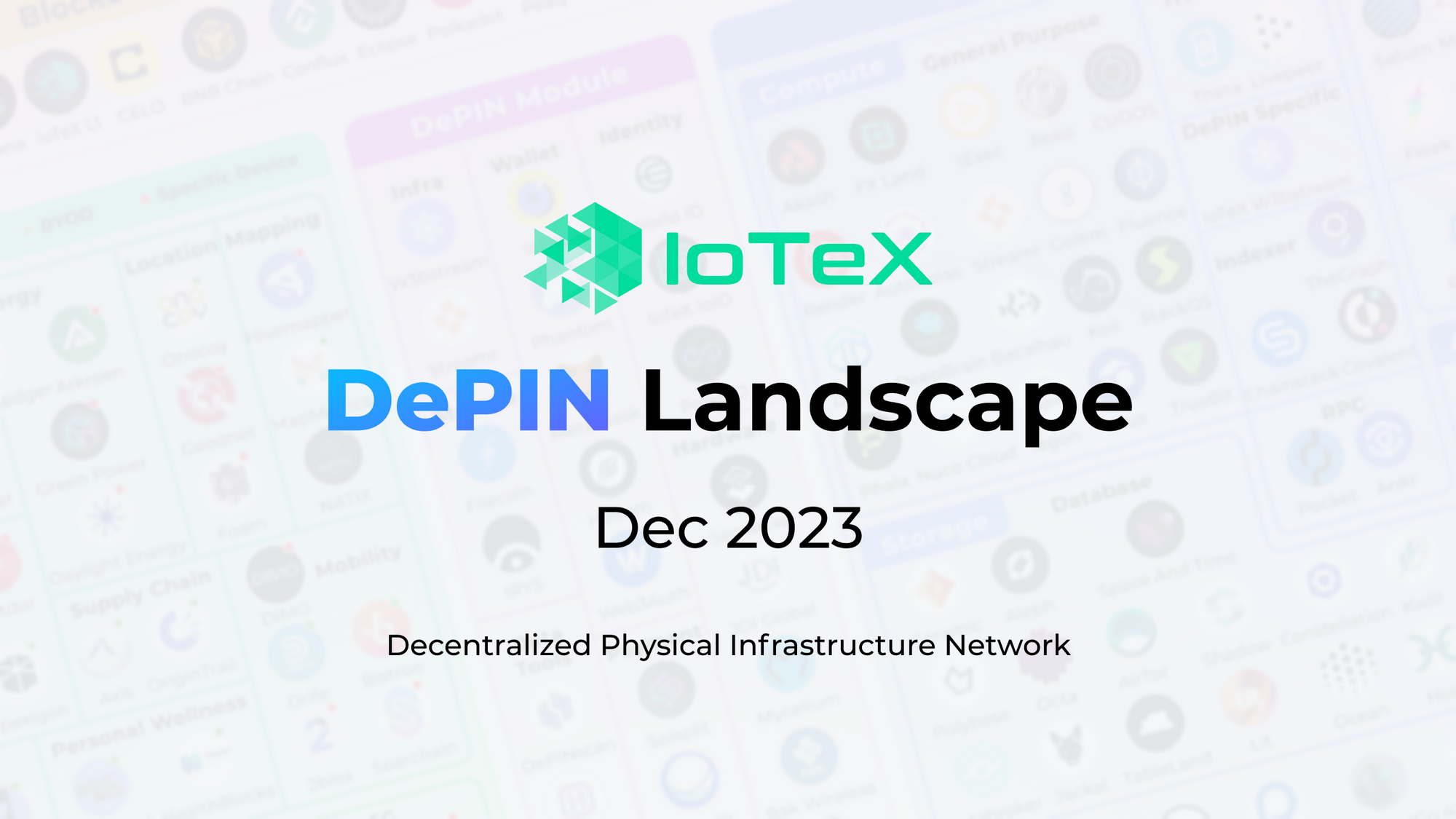
In the ever-evolving world of technology, a new paradigm is emerging, one that combines the power of blockchain technology with real-world sensor capabilities, connectivity, compute resources, and artificial intelligence. These innovative networks are known as Decentralized Physical Infrastructure Networks, or DePINs. DePINs aim to disrupt traditional models of physical infrastructure by utilizing crypto-economic incentives to drive crowdsourced development, ultimately transforming the way we think about and build the world around us.
Read more: What are Decentralized Physical Infrastructure Networks (DePIN)?
IoTeX has always been dedicated to the intersection of the real world and Web3 –DePIN embodies this. Now, IoTeX's off-chain compute protocol W3bstream plays a pivotal role in the ecosystem by catalyzing and expediting the go-to-market timelines for emerging DePIN projects.
As a DePIN crypto sector pioneer and the modularized infrastructure provider for DePIN crypto projects, IoTeX's mission is to unify the landscape and create a clear taxonomy, making DePIN more accessible to all. In this fast moving sector, we are committed to keeping this landscape updated regularly and ensuring that it remains a trusted resource for newcomers and DePIN experts alike.
For a deeper and more transparent understanding of the DePIN environment, DePINscan offers a real-time explorer showcasing the deployment of devices across DePIN crypto projects on a global scale.
Mapping the DePIN Crypto Project Landscape: The Phygital Resource Networks
DePINs are a groundbreaking concept, harnessing the potential of tokenized incentives to motivate individuals to participate in the development of physical infrastructure networks. These networks offer tangible goods and services, and by aligning contributors around common objectives, DePINs enable the decentralized construction and maintenance of infrastructure that has historically been controlled by centralized entities. Participants are incentivized to provide any demanded resource capacity to earn rewards. A wireless network might reward those who set up hotspots. A compute network could compensate those who lend server capacity.
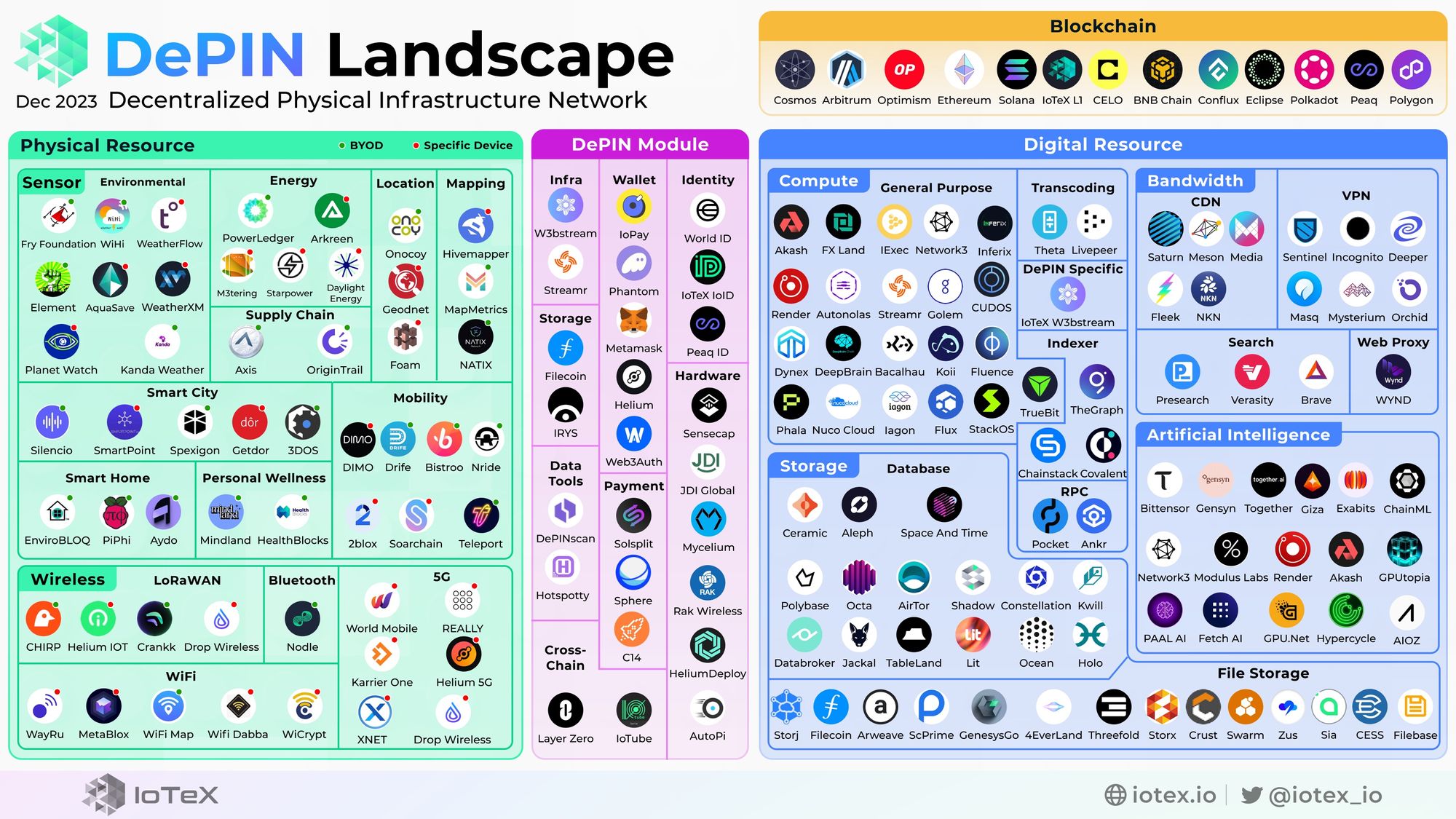
DePIN Module
The modular concept of the DePIN stack empowers developers to plug and play these building blocks to create customized infrastructure networks tailored to specific use cases. These composable modules lower barriers to entry and encourage innovation by allowing developers to focus on the components that matter most for their particular DePIN project. This flexibility, combined with the crypto-economic incentives of DePINs, holds the promise of transforming the future of physical infrastructure in a decentralized and inclusive manner.
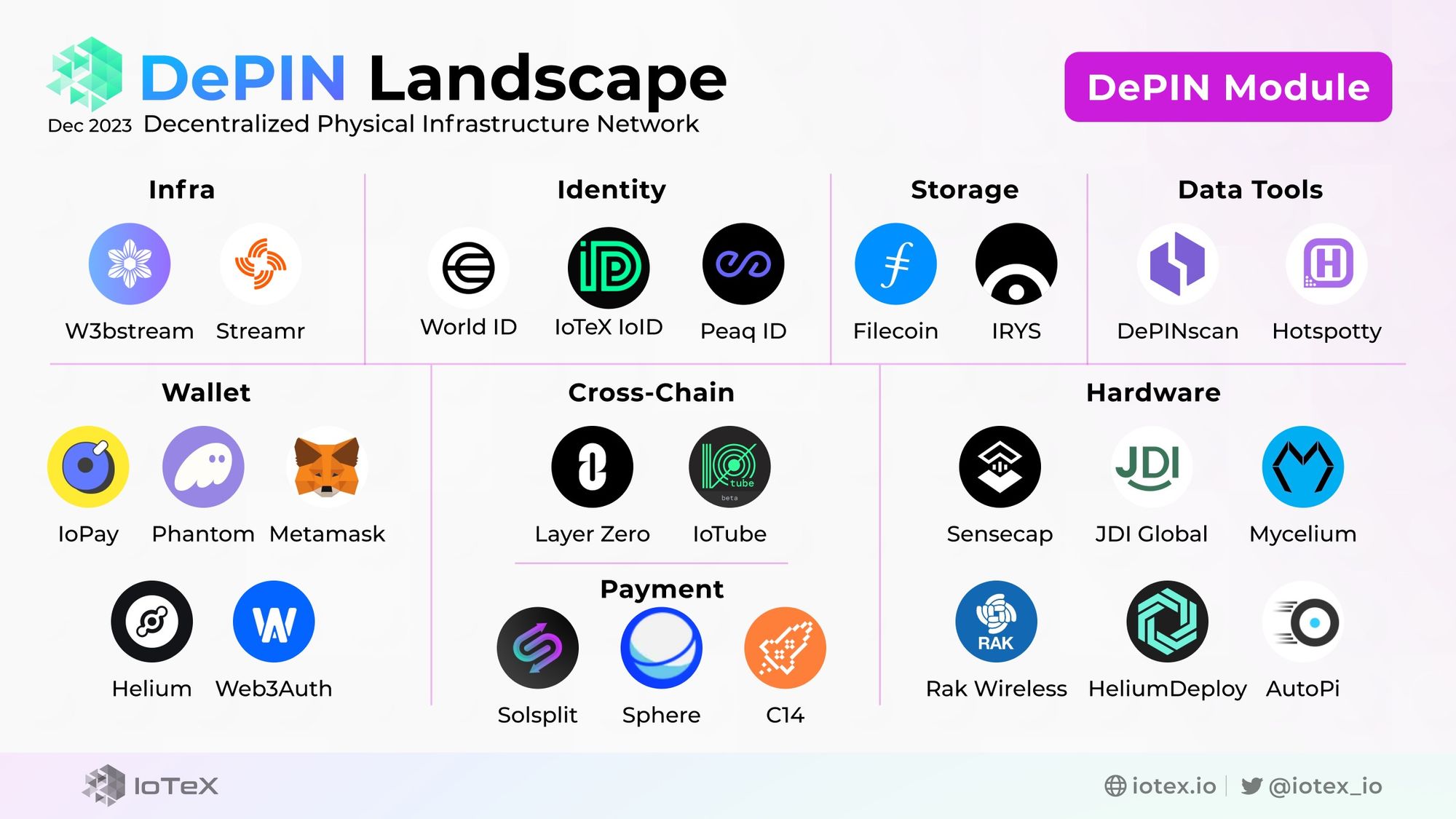
Infra
- Examples: IoTeX W3bstream, Streamr
- The Infra module is a fundamental building block that provides a framework and set of tools for developers to create, deploy, and manage DePINs.
Wallet
- Examples: IoTeX ioPay, Phantom
- A Wallet module serves as a crucial component in the DePIN stack, as it allows users to securely store, manage, and transact with the network's native tokens and assets.
Identity
- Examples: World ID, IoTeX ioID
- The Identity module is responsible for managing device identities and ensuring security within the DePIN network.
Storage
- Examples: Filecoin, Irys
- Storage modules address the critical need for reliable and decentralized data storage and retrieval availability within DePINs.
Payment
- Examples: Solsplit, Sphere
- The Payment module manages the financial aspects of the DePIN network, facilitating transactions and economic interactions among participants.
Data Tools
- Examples: DePINscan, Hotspotty
- Data Tools are essential for processing, analyzing, and visualizing the vast amounts of data generated by DePINs.
Hardware
- Examples: Seeed, Mycelium
- The Hardware module deals with the physical components that make up the DePIN network.
Crosschain
- Examples: IoTeX ioTube, Layerzero
- Crosschain modules facilitate interoperability between different blockchain networks and enable DePINs to leverage the capabilities of multiple blockchains.
Blockchain Layer
The blockchain layer in DePIN serves several important functions, primarily revolving around token settlement, reward distribution, the exchange of services, and providing a medium for composability among DePIN data and networks. According to Messari's DePIN chain classification, there are three types of blockchain layer: DePIN specific blockchains, General Purpose and App-chain.
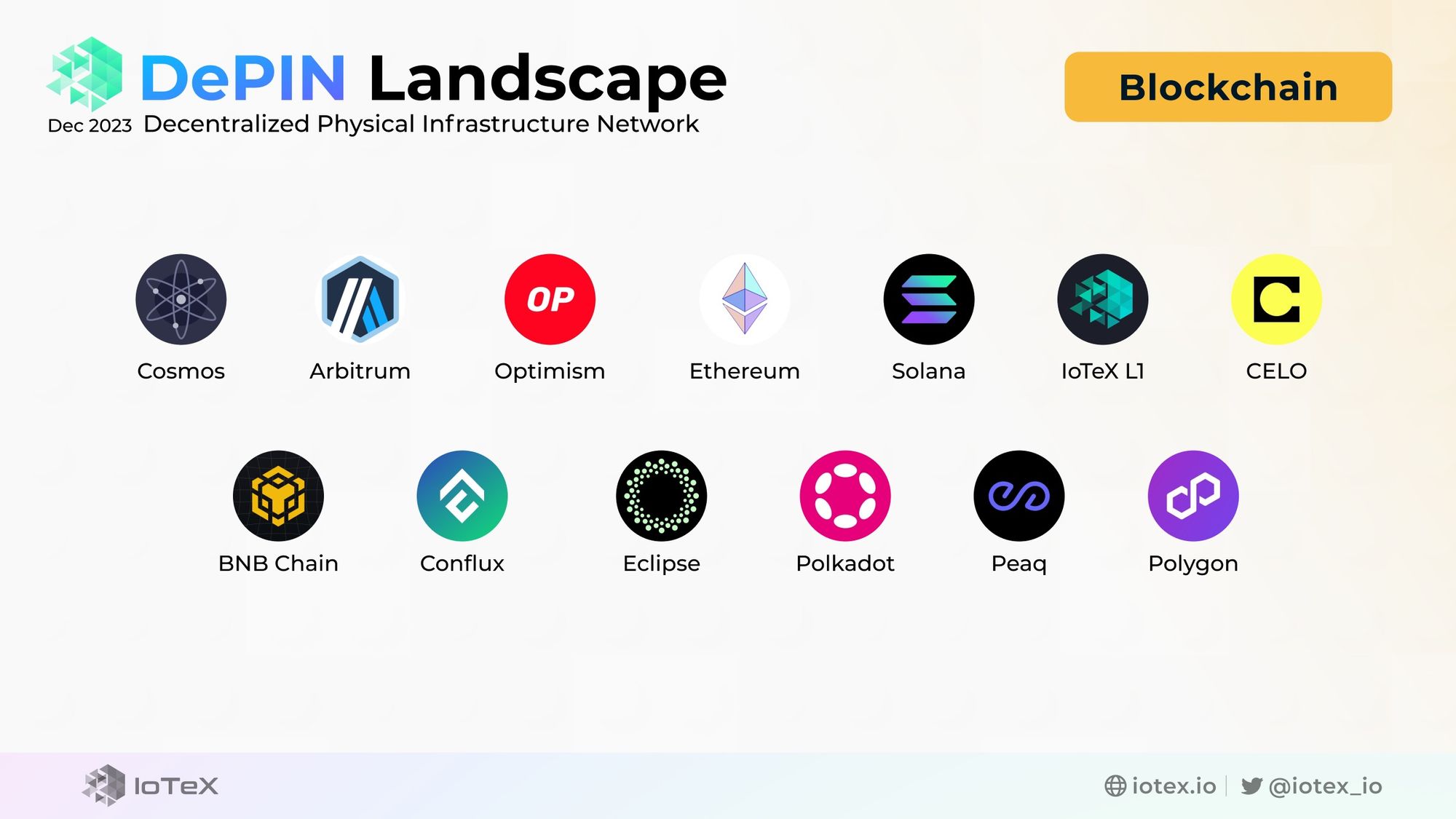
DePIN-Specific Blockchains
- Example: IoTeX L1
- DePIN-specific blockchains are customized for the unique needs of DePIN networks. IoTeX, for instance, specializes in the Internet of Things (IoT) and can be specifically designed to cater to the hardware, connectivity, middleware, blockchain and tokenomics of DePIN projects.
General-Purpose Blockchains
- Examples: Ethereum, Solana, Polygon
- General-purpose blockchains like Ethereum, Solana, and Polygon offer the flexibility and security needed for the core DePIN infrastructure. They can handle a wide range of decentralized applications and smart contracts, making them suitable for managing tokens, rewards, and the governance of DePIN.
App-Chain Blockchains
- Examples: Polkadot, Cosmos, Ecplise
- App-chain blockchains, as part of multi-chain ecosystems like Polkadot and Cosmos, allow DePIN to create specific blockchains or parachains for specialized purposes. These can be tailored to handle distinct services or data, ensuring efficient operation within the DePIN ecosystem and integration with other blockchain networks.
As proposed by Messari's "Navigating the DePIN Domain", DePINs can be categorized into two main groups:
- Physical Resource Networks: These networks incentivize the deployment of location-dependent devices that provide unique, non-fungible offerings linked to geography. These offerings can include wireless coverage, environmental data, imagery, and more. The hardware used is often retail or consumer-grade, making it accessible to a wide range of participants.
- Digital Resource Networks: In these networks, contributors allocate their unused digital capacity, such as bandwidth, storage, and computing power. These decentralized resources become fungible commodities that compete with traditional cloud service providers based on cost and accessibility.
Physical Resource Networks
Physical Resource Networks represent a category within DePINs that focus on the deployment of devices, sensors, and hotspots designed to provide infrastructure capabilities and transmit valuable data. These networks can be further divided into two main approaches based on device requirements:
Specific Devices Designed for a Single Use Case
In this approach, devices are purpose-built for a specific use case or application. These devices are tailored to meet the exact requirements of the use case, resulting in optimal performance and functionality. The advantage of specific devices is that they can deliver highly specialized data, which is crucial for certain industries.
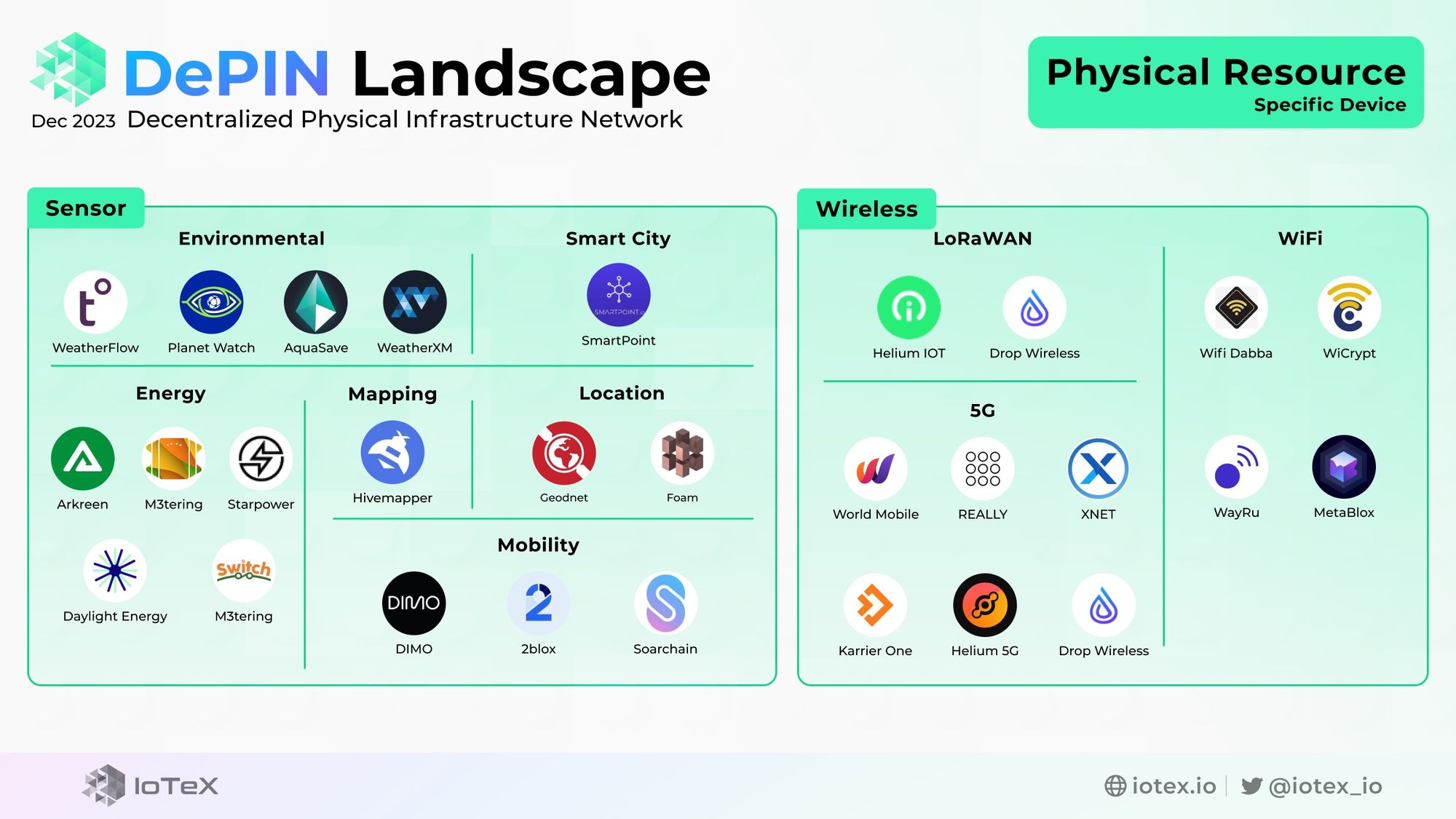
BYOD (Bring Your Own Device) Allowing Any Sensor to Connect
In contrast to specific devices, BYOD approaches embrace a more open framework. They allow any sensor or device to connect to the network, provided it meets certain compatibility standards. This inclusivity encourages a broader range of participants and sensor types.
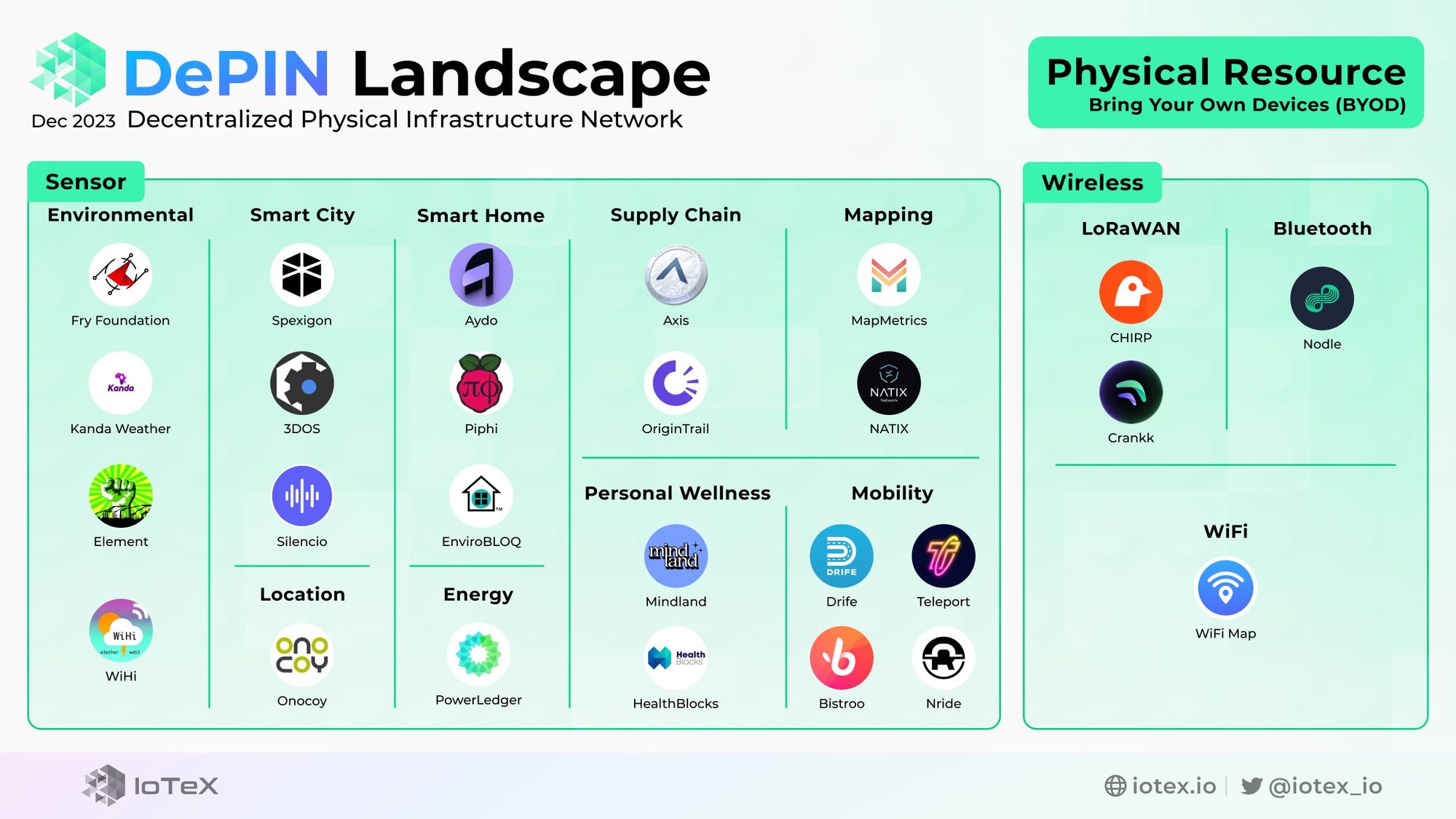
Sensor Networks
Sensor networks act as the "sensory" part of the DePIN projects, collecting data from the physical world and sending it to decentralized infrastructure.
Mobility
- Examples: DIMO, Drife
- Mobility sensors are designed to monitor and provide data related to the movement and transportation of objects and people. They play a crucial role in applications where tracking, navigation, and logistics are essential.
Mapping
- Examples: Hivemapper, Natix
- Mapping sensors are used to capture geographic and topographic data, enabling the creation of maps and spatial models. These sensors help in spatial analysis, urban planning, and environmental monitoring.
Location
- Examples: GEODNET, Onocoy
- Location sensors determine the geographical coordinates of an object or device. They are essential for various applications where knowing the precise location is crucial.
Energy
- Examples: Daylight Energy, M3tering
- Energy sensors are employed to monitor and optimize energy consumption and distribution. They play a critical role in sustainability and resource efficiency.
Environmental
- Examples: WeatherXM, Planet Watch
- Environmental sensors are used to monitor various aspects of the environment, including air quality, weather conditions, water quality, and ecosystem health.
Personal Wellness
- Examples: Sweat, Healthblock
- Personal wellness sensors are wearable or portable devices that track and monitor individual health and well-being, providing valuable data for health management.
Smart Home
- Examples: Envirobloq, PiPhi
- Smart home sensors are integrated into residential environments to enhance convenience, security, and energy efficiency.
Smart City
- Examples: Elumicate, Smart Point
- Smart city sensors are deployed in urban environments to collect data on various aspects of city life, enabling efficient urban planning and management.
Supply Chain
- Examples: OriginTrail, Axis
- Supply chain sensors are used to track the location and condition of goods and assets during transportation and logistics operations.
Wireless Networks
Wireless networks serve as the connectivity layer in the DePIN stack, facilitating the transport of data and services in a decentralized and cost-effective manner.
5G
- Examples: Helium Mobile, Karrier One
- 5G networks offer high-speed data transmission and low latency, making them ideal for applications like augmented reality, autonomous vehicles, and ultra-high-definition video streaming.
WiFi
- Examples: Wicrypt, WiFiMap
- WiFi networks provide local wireless connectivity, often used in homes, businesses, and public spaces to offer internet access and interconnect devices within a specific area.
Bluetooth
- Examples: Nodle
- Bluetooth is a short-range wireless technology often used for connecting peripherals to devices, such as wireless headphones, speakers, and keyboards.
LoRaWAN (Long Range Wide Area Network)
- Examples: Helium IoT, Drop Wireless
- LoRaWAN is designed for long-range, low-power communication, making it suitable for IoT and sensor networks that require extended battery life and wide coverage.
Digital Resource Networks
In Digital Resource Networks, a diverse set of components, including bandwidth resources like CDNs and VPNs, compute resources for general and specific purposes, storage resources for databases and file storage, and AI capabilities for machine learning and data models, collectively underpin efficient data processing, storage, and delivery, enabling a wide array of digital services and applications.
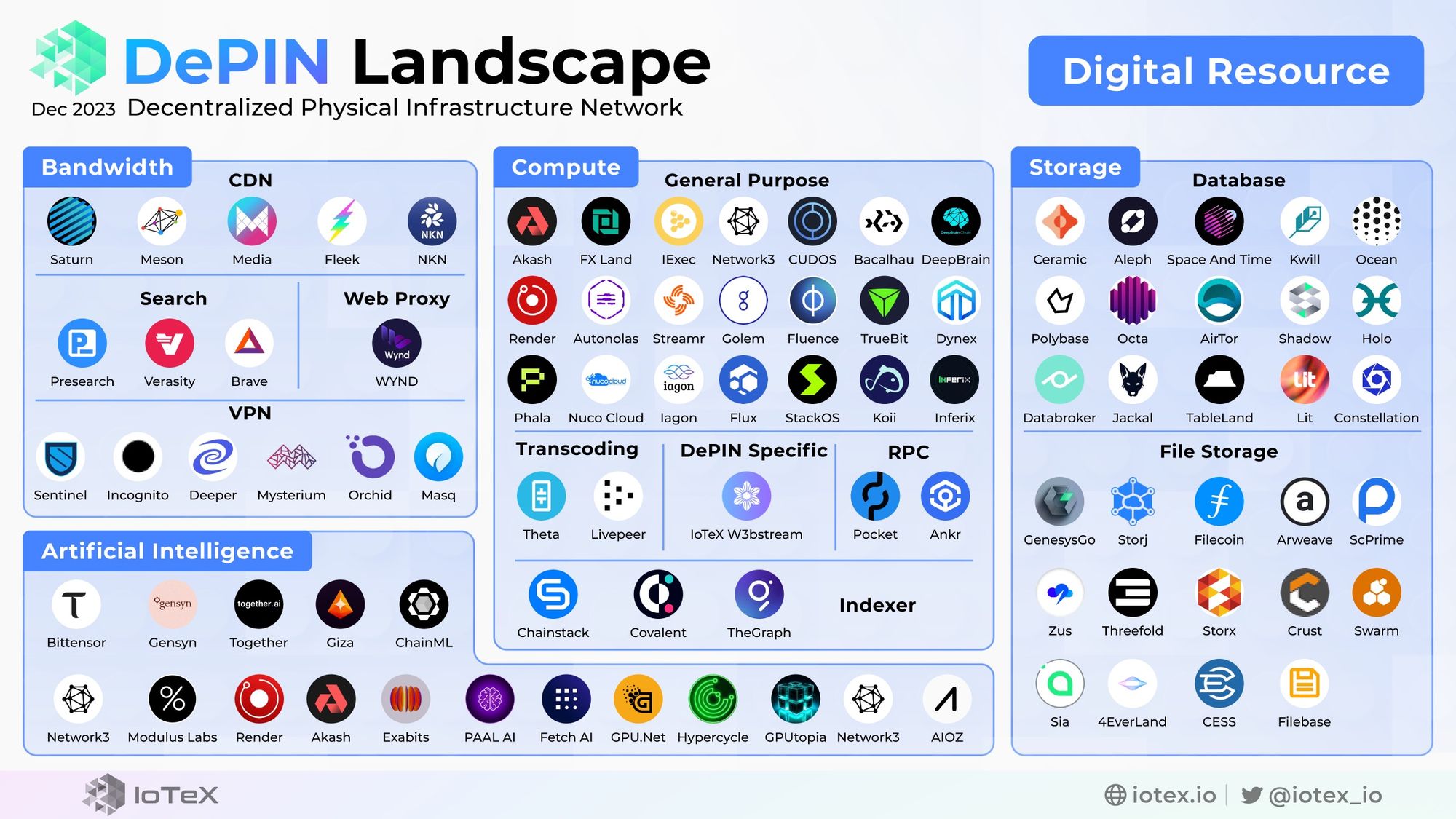
Bandwidth
CDN (Content Delivery Network)
- Examples: Saturn, Meson, Fleek
- CDNs are a key component of Digital Resource Networks, serving to optimize content delivery to end-users. They consist of a distributed network of servers strategically positioned to reduce latency and improve the performance of web services. CDNs enhance website loading speed, video streaming quality, and overall user experience.
VPN (Virtual Private Network)
- Examples: Orchid, Mysterium
- VPNs are critical for ensuring secure and private communication within digital networks. They provide encrypted connections over the internet, safeguarding data from potential threats and ensuring privacy, making them a valuable resource within Digital Resource Networks.
Browser
- Examples: Presearch, Brave, Verasity
- Web browsers are fundamental in accessing and interacting with digital resources. They offer a user-friendly interface for navigating the internet, and their efficiency and compatibility with various web technologies are crucial in ensuring the effective use of digital resources.
Web Proxy
- Examples: Wynd
- Web proxies act as intermediaries between users and web servers, enhancing security, privacy, and performance. They are valuable components of Digital Resource Networks for managing network traffic, ensuring data integrity, and protecting user identities.
Compute
General Purpose
- Examples: Render, Akash
- General-purpose computing resources serve as the versatile workhorses of Digital Resource Networks. They can perform a wide range of computing tasks and are used for tasks like running applications, hosting websites, and managing data.
Specific Purpose
- Transcoding resources convert media files into various formats: Livepeer
- Indexer resources organize and index data for efficient retrieval: The Graph
- RPC (Remote Procedure Call) resources facilitate communication between different parts of the network: ANKR
- DePIN-specific proof logic compute: IoTeX w3bstream
Storage
Database
- Examples: Aleph, Space and Time
- Databases are a critical component of Digital Resource Networks, serving as repositories for structured data. They enable efficient data management, retrieval, and processing, making them invaluable for a wide range of applications, including content management systems, e-commerce, and data analytics.
File Storage
- Examples: Filecoin, Arweave
- File storage resources provide a means for storing and retrieving unstructured or semi-structured data, such as documents, images, and multimedia files. They are essential for content sharing, document management, and media distribution within the network.
AI (Artificial Intelligence)
AI capabilities in Digital Resource Networks encompass a variety of tools and resources for machine learning, deep learning, and artificial intelligence applications. These capabilities include:
Machine Learning Models
- Examples: Gensyn, Together
- Trained machine learning models for tasks such as natural language processing, image recognition, and predictive analytics.
AI Frameworks
- Examples: Fetch AI, Paal AI
- Software libraries and frameworks that facilitate the development and deployment of AI applications.
GPU Marketplace
- Examples: Exabits, GPU.net
- Specialized hardware marketplace, such as GPUs and TPUs, that enhance the performance of AI workloads.
Why It Matters
The emergence of Decentralized Physical Infrastructure Networks (DePINs) represents a paradigm shift in how we think about and interact with our physical surroundings. By leveraging blockchain technology, sensors, connectivity, computing, and AI capabilities, DePINs enable the crowd-sourced development of physical infrastructures that were once the exclusive domain of centralized entities.As DePINs continue to gain traction, we can anticipate a world where the boundaries between the digital and physical realms blur, where individuals are not just consumers but active contributors to the infrastructure that powers our daily lives. The decentralized future of infrastructure is upon us, and it promises to be an exciting journey into uncharted territory, where the power of technology is harnessed for the benefit of all. We invite everyone who builds the DePIN projects to get in contact with us in updating the DePIN landscape map. Reach out to us at [email protected].
About IoTeX
IoTeX is a modular Web3 infrastructure platform connecting smart devices and real-world data to blockchains. IoTeX’s middleware solution W3bstream provides the computation and verification of real-world data, bringing it on-chain while offering the modularity and customizability builders need to facilitate mass adoption. As the leading provider of DePIN infrastructure, IoTeX facilitates new rewards from devices and on/off-chain activity for users, turns personal devices into communal economies, and tokenizes the "data of everything." Backed by a global team of 60+ research scientists and engineers, IoTeX combines its EVM-compatible L1 blockchain, off-chain compute middleware, and open hardware to connect billions of smart devices, machines and sensors, and dApps across the physical and digital world.
Website | Twitter | Developer Twitter | Developer Portal | Reddit | Discord | YouTube
